
This article is lengthy, with a total reading time of 10 minutes.
# Author: Roff Segger, Technical Testing, Translation, and Writing at SEGGER
We are testing using SEGGER’s Embedded Studio development environment: on a Cortex-M microcontroller, how much Flash memory is needed to complete a blinking LED application?
Objective:
· Complete a blinking application using a program of less than 100 bytes
· Use a switching frequency easily visible to the human eye (i.e., in the range of 1-5Hz)
· The main program is written in C/C++
· Use readily available hardware
· Do not use or disable the runtime system initialization of the toolchain
This article will roughly introduce every byte and instruction we will use. It is a good way to understand what happens during system startup, specifically what occurs at the “low level” before reaching the main() function.
In short: Using the Embedded Studio development environment, this task can be accomplished within a program of less than 100 bytes.
01
Hardware
The hardware we are using is an STM32 Trace Reference Board. It is very simple, containing only an STM32F407 microcontroller, 3 LEDs, a debug/trace interface, and a USB power port.
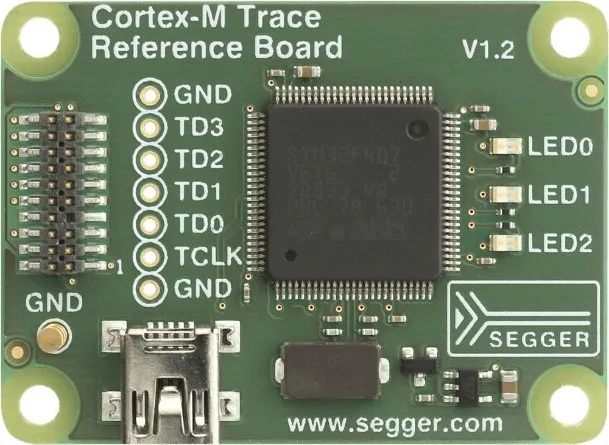
Each J-Trace emulator comes with this development board; however, here I am simply using the regular J-Link functionality to download and debug the program. Users can also choose any hardware with an LED for testing.
02
Generating the Project
It is very simple: open the Embedded Studio development environment, select File -> New Project from the menu, choose the first option to create an executable file.
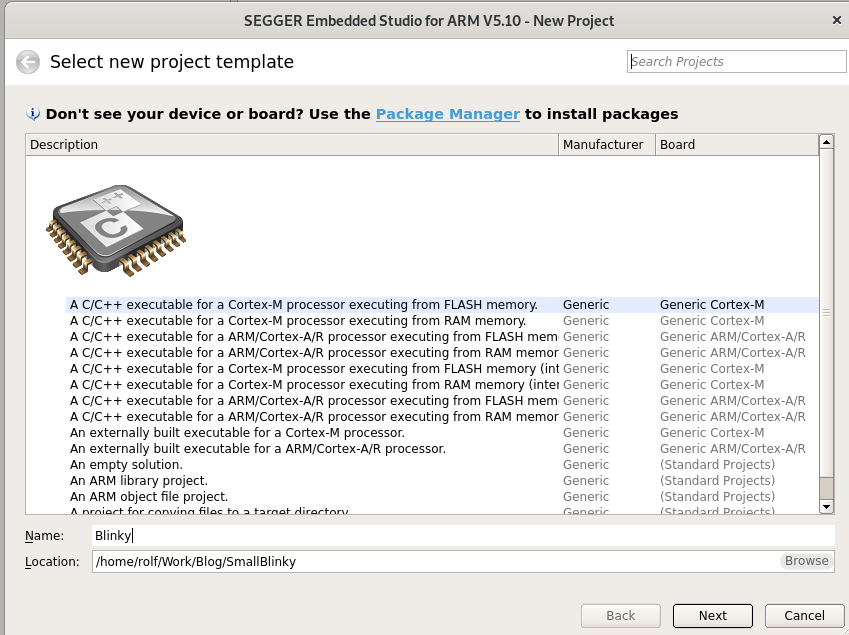
Follow the prompts, select the default values, click next a few times, and I finally get a small project as shown in the Project Explorer window below.
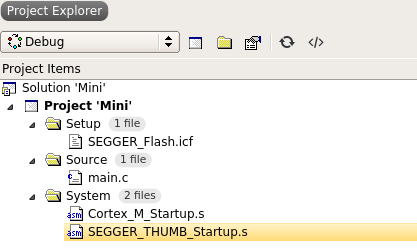
Select Build -> Build Mini or press F7 to build our program.
Debug -> Go or F5 to start the debugger.
We are currently not connected to hardware, so Embedded Studio requires us to use the built-in simulator.
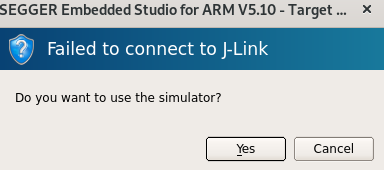
Click Yes or press Enter to start the simulator.
The debugger stops at the main() function, which is a standard “Hello world” application.
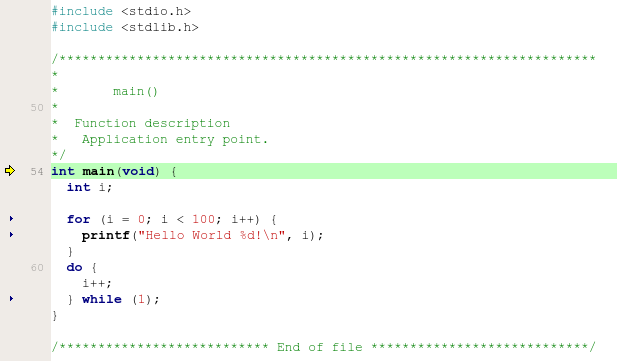
Now, to achieve the minimal application, we will simplify it to a basically empty loop.
int main(void) { int i; do { i++; } while (1);}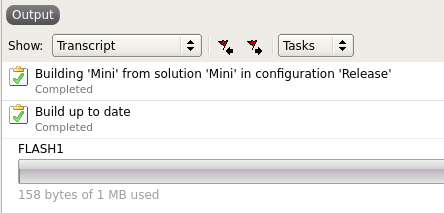
The result occupies only 158 bytes of Flash. This is already quite good, but before adding the actual LED blinking functionality, I need to understand the memory usage and how to minimize my program.
To do this, I can check the Memory Usage Window, the linker map file, the generated ELF file, or simply look at the Project Explorer.
From the Project Explorer window, it can be seen that this executable file consists of 3 source program files and how much Code + RO space they use. Note that these are the values generated by the compiler for the object files. For the final executable file, the linker can eliminate unused functions or add some glue code (from Flash to RAM or from Thumb instructions to ARM instructions) and padding (e.g., to ensure 4-byte alignment) as necessary.
Another place using Flash memory may be the code linked from libraries, such as the C runtime library. However, our small project does not use library functions, so we do not have to consider the space occupied by library code.
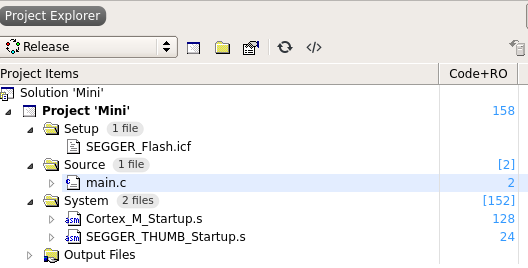
Moreover, the Project Explorer shows the memory usage of each source file (2, 128, and 24 bytes) and the total memory usage of the project executable: 158 bytes. This matches the values we see in the Output window.
03
Understanding Project Structure
What are the purposes of these three files? Our application is just a simple main() function. Why do I need the other two files?
🔹main.c – The application.
🔹Cortex_M_Startup.s – CPU-related code, including the interrupt vector table.
🔹SEGGER_THUMB_Startup.s – Code that the application programmer does not need to modify.
Let’s take a closer look at them to unveil the mystery everyone wants to know: how does the startup code work?
With this knowledge, let’s see how to shrink our application.
04
main.c
main.c contains our application, a very simple main() function.
Our compiler is smart enough. It can see that this program does nothing and optimize it to an empty loop that uses only one instruction or two bytes of code.
How do I know this? We can look at main.o, which is the output generated by the compiler. In the Project Explorer, right-click on main.c -> Show Disassembly, or expand it and double-click on main.o in Output files. It reveals that the main program has only one branch.

This is our main application. We cannot simplify it any further.
05
Cortex_M_Startup.s
Cortex_M_Startup.s contains the CPU-related code needed for the application to run on Cortex-M hardware. It includes the interrupt vector table and the function executed on power-up or reset: Reset_Handler.
This file uses most of the Flash space. Let’s take a closer look at what it generates.
Cortex_M_Startup.o shows that it contains the interrupt vector table .vectors section and the default implementation of the exception handlers.
section .vectors<_vectors>00000000 .word 0x0000000000000000 .word 0x0000000000000000 .word 0x0000000000000000 .word 0x0000000000000000 .word 0x0000000000000000 .word 0x0000000000000000 .word 0x0000000000000000 .word 0x0000000000000000 .word 0x0000000000000000 .word 0x0000000000000000 .word 0x0000000000000000 .word 0x0000000000000000 .word 0x0000000000000000 .word 0x0000000000000000 .word 0x0000000000000000 .word 0x00000000 section .init.NMI_Handler<NMI_Handler>E7FE b 0x00000000 section .init.MemManage_Handler<MemManage_Handler>E7FE b 0x00000000 section .init.BusFault_Handler<BusFault_Handler>E7FE b 0x00000000 section .init.UsageFault_Handler<UsageFault_Handler>E7FE b 0x00000000 section .init.SVC_Handler<SVC_Handler>E7FE b 0x00000000 section .init.DebugMon_Handler<DebugMon_Handler>E7FE b 0x00000000 section .init.PendSV_Handler<PendSV_Handler>E7FE b 0x00000000 section .init.SysTick_Handler<SysTick_Handler>E7FE b 0x00000000 section .init.Reset_Handler<reset_handler><Reset_Handler>F7FFFFFE bl 0x00000000F7FFBFFE b.w 0x00000004 section .init.HardFault_Handler<HardFault_Handler>4908 ldr r1,680A ldr r2, [r1]2A00 cmp r2, #0<hfLoop>D4FE bmi 0x00000006F01E0F04 tst lr, #4BF0C ite eqF3EF8008 mrseq r0, mspF3EF8009 mrsne r0, pspF0424200 orr r2, r2, #0x80000000600A str r2, [r1]6981 ldr r1, [r0, #24]3102 adds r1, #26181 str r1, [r0, #24]4770 bx lrE000ED2C .word 0xE000ED2CThis is the culprit.
The ARM core defines the first 16 entries in the vector table, followed by entries for external device interrupts. This file provides a vector table with 16 entries (or 64 bytes). These entries are only used for that table.
In the application, we do not handle any faults or interrupts; in fact, we only need the Reset_Handler, which is the code executed immediately upon reset. We also need the first entry in the vector table, which initializes the stack pointer (SP) upon reset.
Therefore, we can remove all unnecessary entries, reducing this table to two entries while eliminating the default exception handlers.
We regenerate the application. Nice! Now the application has been reduced to 42 bytes.
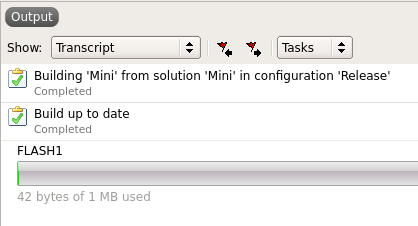
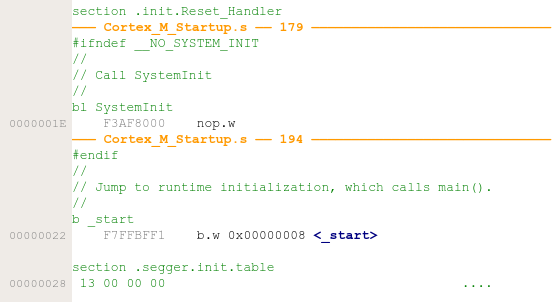
Let’s take a look at the contents of the output ELF file.
From 0x0000 0000, the first 8 bytes: the vector table, containing the initialization SP and a pointer to Reset_Handler.
From 0x0000 001E, the next 8 bytes: Reset_Handler, two 4-byte instructions. A nop instruction inserted by the linker replaces the call to SystemInit (which does not exist in the application), followed by a jump to _start.
From 0x0000 0008, the next 20 bytes: the general runtime initialization from SEGGER_THUMB_Startup.s, which performs the initialization function calls generated by the linker from SEGGER_init_table, then calls main, and if main returns, it stops in the exit loop.
From 0x0000 0028, the next 4 bytes: the linker generates SEGGER_init_table,
which contains the initialization functions that need to be called before main. It may include section initialization (copying initialized data), section filling (for zero-initialized static variables or pre-filling the stack), heap initialization, or calling constructors for global C++ objects. None of these are used in our application.
The last (and only) instruction is a jump to the end of runtime initialization, calling the main function.
Plus, from 0x00000026, the 2 bytes of padding for aligning SEGGER_int_table, totaling 42 bytes.
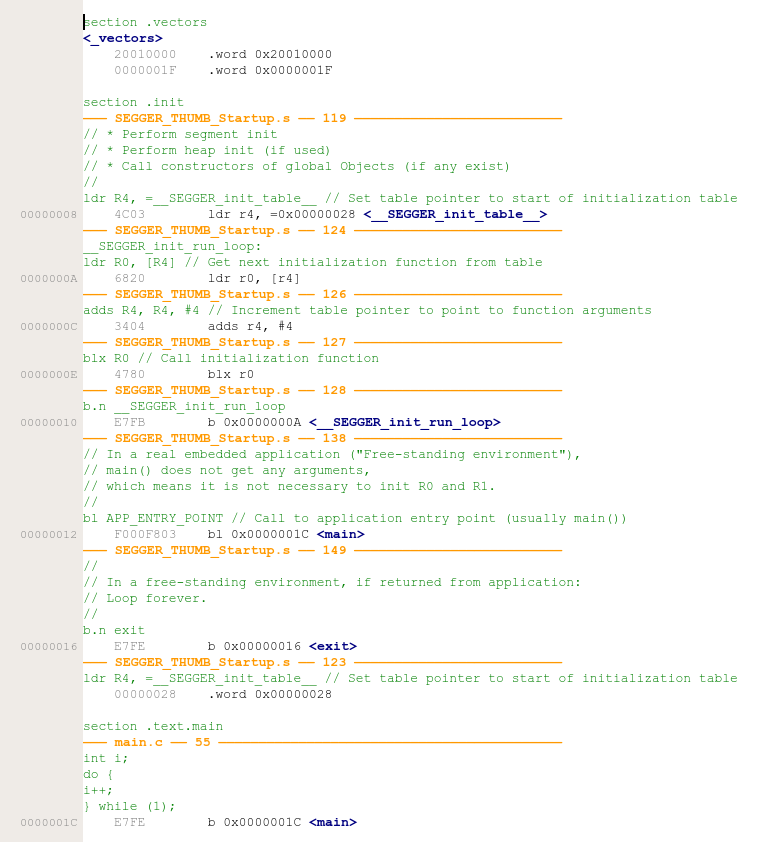

Since the application does not use the SystemInit function, we can remove the bl SystemInit statement and replace it with a nop to save 4 bytes, reducing it to 38+2=40 bytes.
Our application is already as small as possible. Next, we will start adding the blinking code!
06
Adding Blinking Code
We wrote some code to initialize and control the LEDs on the reference board and a simple delay function.
With this code, we can create the main application with blinking functionality, as shown below:
/****************************************** main()** Function description* Application entry point.*/int main(void) { _InitLED(); for (;;) { _SetLED(); _Delay(NUM_DELAY_LOOPS); _ClrLED(); _Delay(NUM_DELAY_LOOPS); }}The complete source code project is accessible (click “Read the original”):https://blog.segger.com/wp-content/uploads/2020/08/Blinky_Mini.zip
Let’s rebuild and check the output.
Success! The size of the application is only 96 bytes (it needs to be built in release mode; the code size will be larger in debug mode).
Can it really run? Let’s try it. We will connect the board to J-Link and connect J-Link to our computer. Press F5 to run it. Just like at the beginning of this project, the debugging session starts and runs to the main function, only this time on actual hardware instead of the simulator. When we click F5 again to continue execution, we can see LED0 on the development board blinking.
07
Summary
The blinking program written in C can indeed fit into a program of less than 100 bytes (or more accurately, in read-only) memory.
The startup code does not need to be that complex. It simply completes the hardware initialization (the purpose of SystemInit) and the runtime system initialization.
The runtime system initialization is handled by Embedded Studio and the SEGGER linker. It ensures that only the necessary code is included to make the generated executable as small as possible.
The SEGGER linker can also include specific initializations, such as completing heap initialization and calling constructors when needed. These functions are controlled by scripts in the linker.
initialize by symbol __SEGGER_init_heap { block heap }; // Init the heap if there is oneinitialize by symbol __SEGGER_init_ctors { block ctors }; // Call constructors for globalobjects which needThe startup code generated by the SEGGER linker is very small and easy to understand. With the efficient SEGGER compiler combined with modular runtime libraries and the host-side output printf() function, we can stand out.
Take a look at the size of a simple “Hello World” program on a computer; perhaps we should also provide a SEGGER Studio that can generate the same small program on a computer.
Can your program be even more compact? Try it with your toolchain and challenge to write a blinking program in 100 bytes! I believe it will be hard to beat on the same hardware.
08
Can the code for this project be made even tighter?
The surprising answer is: yes.
First: some microcontrollers have toggle registers that allow the loop to be split into _ToggleLED() / Delay().
Also, the amount of code needed for initialization varies, and it may be smaller on other hardware.
But even on the same hardware, we can further reduce the program size.
We can place _start in the vector table so that the program can start executing in the general startup code, saving 4 bytes of jump space.
We can remove exit() and the 2-byte branch because we know that the main() program will never return.
Since I only want a program of less than 100 bytes, let’s stop here.
Happy coding!
Follow our WeChat public account 【SEGGER Technology】, reply “Join Group” to join the technical exchange group.
Product inquiries:
Beijing: 010-62975900
Shanghai: 021-62127690
Shenzhen: 0755-82977971

Share, view, and like; at least I want to have one.
